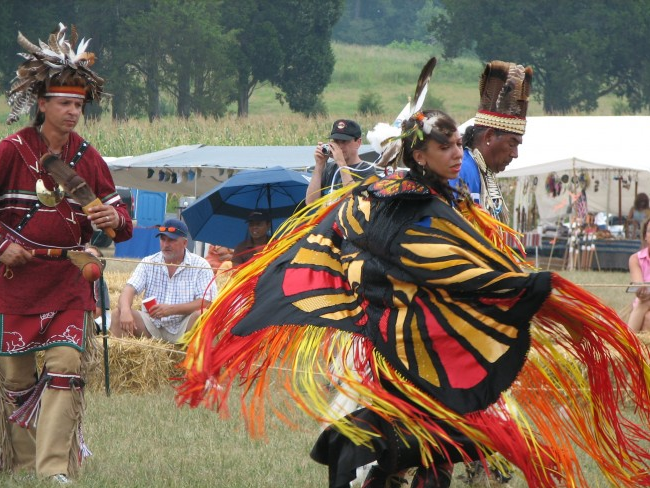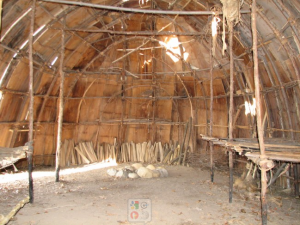Jordan Wright
October 10th, 2011
Indian Country Today Media Network
When the harvest moon rises over the Potomac in early autumn, it is a slow aqueous climb that silhouettes the shoreline and turns the river’s blue-green waters into the color of molten obsidian. Under the same amber moon in 10,000 B.C. prehistoric people plied the waters in dugout canoes carved from tulip poplar and built their bonfires along the coastal marshes. They combed the primordial forests hunting for fish and game not unlike the Piscataway tribes who have called these lands their home for over 500 years and whose history still threads through the region like the rivers and creeks that crisscross the land.
The Beaver Clan, as they are known, inhabit a modern world in an area of Southern Maryland, graced with thousands of protected acres of woodland and coastal waters lining the Potomac, Anacostia and Patuxent Rivers and on out to the Chesapeake Bay. It is rich with the history of tribal occupation and the early colonists. Whether you travel by foot, car, bicycle or kayak these are some of the ways the modern explorer can sense, see and relive Maryland’s ancient past while enjoying its fall colors.
Prince George’s County
Late this summer archeologists completed a major dig in the Zekiah Swamp that lies beside Mattawoman Creek, south of Waldorf, MD. Their stunning discovery was the long-lost Zekiah Fort, built in the 17th Century for the Piscataway by Governor Charles Calvert, the third Lord Baltimore, it was used to protect the tribe from incursions by the Susquehanna, Seneca and Iroquois.
The location of the fort offers living proof of Piscataway existence in the region since 1200 A.D. The researchers unearthed Native American pottery and glass trading beads side by side with arrowheads made from English brass, a 17th-century English clay pipe, and a silver belt hanger for an English soldier’s sword. Currently the secret location is under the aegis of St. Mary’s College and the Smallwood Foundation, who as co-sponsor of the excavation, hopes to purchase and protect the 95-acre site.
Along Indian Head Highway just outside the Washington DC area the Bryan Point Road takes you to the Accokeek region where according to Captain John Smith’s map of 1612 the village of Moyaone and Mockley Point the principal place for the Tayac and capitol of the Piscataway Nation. Along the road you’ll pass the Alice Ferguson Foundation at Hard Bargain Farm Environmental Center where Alice Ferguson began excavations on her property in 1935 documenting prehistoric encampments through cutting tools, axes, “atlatls” (forerunner of the bow and arrow), pottery, pipes, post mold remnants revealing early stockades and over 600 human skulls in a single ossuary.
On the same road are the Accokeek Foundation, stewards of the 5,000-acre Piscataway Park, and the National Colonial Farm alongside the Potomac River with a view to George Washington’s Mount Vernon home on the Virginia side. Visitors to the farm and park can traverse upland woods and fenced fields dotted with heirloom breeds of cattle, sheep and pigs. At the river’s edge an historical marker describes the history of the Piscataway whose name translates to “where the waters blend”. It overlooks a large field with a burial site and sweat lodge beyond used by the Piscataway Conoy Confederacy and Subtribes and accessible across the wetlands by a wooden boardwalk. Six marked trails provide spectacular views of the river and woodlands. The foundation hosts monthly events to acquaint the public with Native American and colonial traditions with gardening and cooking classes and environmental film screenings. The park and the surrounding area are home to beavers, bald eagles, deer, fox, wild turkey, egrets, osprey, great blue heron and many more of the area’s species. Fishing and boating are permitted at the park.
Charles County
In the nearby town of Waldorf is the home of the Maryland Indian Cultural Center and Piscataway Indian Museum run by the Cedarville Band of Piscataway Indians and directed by tribal chief, Natalie Proctor and her husband Maurice. The five-acre museum site is on an original Nike Missile site. “Moondancer”, a sculpture created by local artist Jim Pollack from old missile parts, reigns beside the fire pit and sweat lodge. The wonderfully informative museum houses hundreds of artifacts from local as well as national tribes and includes descriptions of tribal life in Southern Maryland. A longhouse, the preferred habitation of the local tribes, has been constructed inside the museum. 16816 Country Lane, Waldorf, MD. Visits to the museum are by appointment or during festivals. Call 240 432-5446.
Indian Head, poised at the confluence of the Potomac and the headwaters of the Mattawoman Creek yields further exploration by kayak, standup paddleboat (SUP) or the pedal-driven Hobie kayak along the banks of the Potomac River or on the 23-mile Mattawoman Creek. The nearby Indian Head Rail Trail, designed for walking or cycling, is a 13-mile paved trail one half-mile from the town’s center.
Up The Creek Rentals in Indian Head is open weekends or by reservation during the week and rents all the above equipment. Call 301 743-3733 or 301 743-3506. www.upthecreekrentals.com.
The village of Port Tobacco, once Maryland’s largest seaport and the original site of the Indian settlement of Potomaco is Saint Ignatius Church overlooking the mouth of the Port Tobacco River on a 120-foot bluff. Founded in 1641 it is the nation’s oldest active parish. Inside a unique stained glass window depicts the baptism of Chief Kittamaquund (the “Great Beaver”) – the first Native American Chief to be baptized in the Catholic Church. Piscataway graves can be found in the church’s cemetery and the restored Port Tobacco Courthouse has a small collection of Indian artifacts.
Calvert County
A few miles west of the Chesapeake Bay is the 560-acre Jefferson Patterson Park & Museum in St. Leonard. In 2007 the park recreated an Indian village in commemoration of the 400th anniversary of Captain John Smith’s landing and exploration of the bay and its tidal tributaries. The village, situated beside the Patuxent River, consists of four longhouses, a central fire pit and racks for smoking fish and meat. A cell phone audio tour is available. Activities such as the making of stone tools and clay pots as well as evening campfires are held throughout the year on “Village Days” and the park’s annual American Indian Heritage Day.
The Maryland Archeological Conservation Lab is also located in the park and open to pre-arranged group tours. Over 8 million artifacts are housed here where conservators do restoration and preservation work on site. A Visitors Center provides information on the Paleo-Indians of the region and showcases artifacts from around the state. To plan your visit go to www.jefpat.org.



Leave a Reply